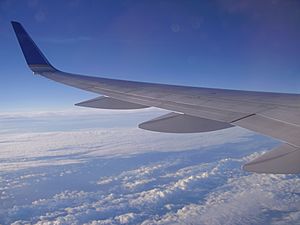Winglet facts for kids
A winglet is a special part found at the very end of an airplane's wing. It usually looks like a small, upward-pointing fin. Its main job is to help the airplane fly more efficiently, which means it uses less fuel (gas). Winglets do this by making the air flow smoother around the wing, which saves energy and helps planes travel further.

Contents
What Do Winglets Do?
When an airplane flies, the air pressure below its wings is higher than the pressure above them. This difference in pressure creates lift, which is the force that keeps the plane in the air. However, at the very tip of the wing, some of the high-pressure air from underneath tries to escape by curling around to the lower-pressure area on top.
This curling air creates swirling patterns called "wingtip vortices" (say: VOR-tih-sees). You can sometimes see these vortices as trails of swirling air or clouds behind a plane, especially on humid days. These vortices create a type of resistance called "induced drag." Drag is a force that pulls the airplane backward, making it work harder to move forward. Induced drag wastes energy and makes the plane use more fuel.
How Winglets Save Fuel
Winglets are designed to reduce these strong wingtip vortices. By pointing upwards, they act like a barrier, making it harder for the air to curl around the wingtip. This helps to keep the high-pressure air under the wing and the low-pressure air above it more separated.
When the wingtip vortices are weaker, the induced drag on the airplane is reduced. Less drag means the engines don't have to work as hard to push the plane through the air. This directly leads to the plane using less fuel, which is good for the environment and saves money for airlines.
Different Kinds of Winglets
Over the years, engineers have designed many different shapes and sizes for winglets. Some common types include:
- Blended Winglets: These are smoothly curved and blend into the wing, looking like a natural extension. They are very common on many modern airplanes.
- Raked Wingtips: Instead of pointing sharply upwards, these wingtips are swept back at a sharp angle, making the wing longer. They achieve a similar effect to traditional winglets.
- Split Scimitar Winglets: These have both an upward-pointing part and a smaller, downward-pointing part, looking a bit like a curved sword (a scimitar). This design can offer even more fuel savings.
- Wingtip Fences: These are smaller, vertical plates on both the top and bottom of the wingtip. They are less common on new planes but were used on some older designs.
Each design aims to reduce drag in slightly different ways, but they all have the same goal: to make airplanes more efficient.
When Were Winglets First Used?
The idea of adding vertical surfaces to wingtips has been around for a long time. Early experiments with similar devices happened in the 1930s. However, the modern winglet as we know it was developed more seriously in the 1970s by an engineer named Richard Whitcomb at NASA.
The first commercial airplanes to widely use modern winglets were the Learjet 28/29 in the late 1970s. Since then, they have become a standard feature on almost all new passenger and cargo planes because of the significant fuel savings they provide. Even some older planes have been updated with winglets to make them more efficient.
Images for kids
-
The Airbus A350 XWB wingtip
-
Winglet on KC-135 Stratotanker with attached tufts showing airflow during NASA tests in 1979–1980
-
Schempp-Hirth Ventus-2 glider with factory winglets winch-launching
-
PSU-90-125 winglet airfoil profile
-
Boeing 747-400 canted winglet
-
Airbus A320 sharklet
-
Boeing 767-400ER with raked wingtips
-
Airbus A310-300 wingtip fence
-
"Winged rotor" on AgustaWestland AW101 Merlin helicopter
See also
 In Spanish: Dispositivo de punta alar para niños
In Spanish: Dispositivo de punta alar para niños




















